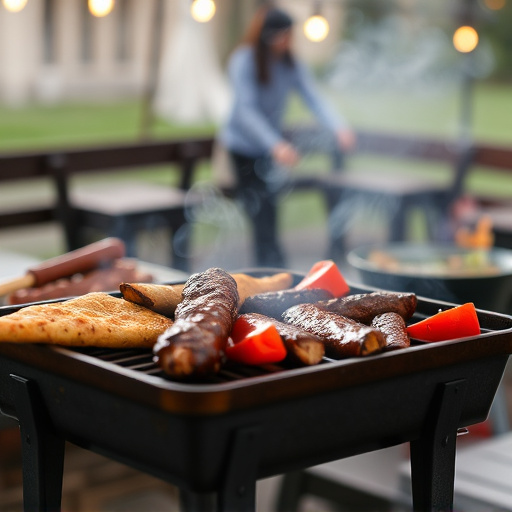Mastering the perfect BBQ Pork Rib Recipe involves understanding rib cuts and preparation methods tailored to each style (baby back, spare rib, St. Louis). Key steps include marinating or dry rubbing for flavor, removing the membrane for tenderness, and cooking at ideal temperatures (200°F – 250°F) for slow breakdown of connective tissues. You can grill ribs with high heat and indirect cooking, or bake them slowly in the oven for even tenderness. Enhance taste with marinades, rubs, and sauces like Kansas City-style or apple cider vinegar glaze. Serve with sides like coleslaw or baked beans for a classic BBQ pork rib experience.
Looking for the ultimate BBQ pork rib recipe? Discover the secrets to achieving perfectly cooked ribs using either a grill or oven. From understanding different rib types to mastering marinades, this guide covers it all. Learn why temperature is key and explore two distinct cooking methods: the smoky grill approach and the slow-and-steady oven technique. Elevate your BBQ game with expert tips on serving and pairing these mouthwatering ribs.
- Understanding Ribs: Types and Preparation
- The Science Behind Cooking Ribs: Why Temperature Matters
- Grill Method: Achieving That Charred, Smoky Flavor
- Oven Method: A Slow and Steady Approach for Tender Ribs
- Marinades and Rubs: Enhancing the Flavor Profile
- Choosing the Right BBQ Sauces for Your Ribs
- Tips for Serving and Pairing Your Perfect Ribs
Understanding Ribs: Types and Preparation
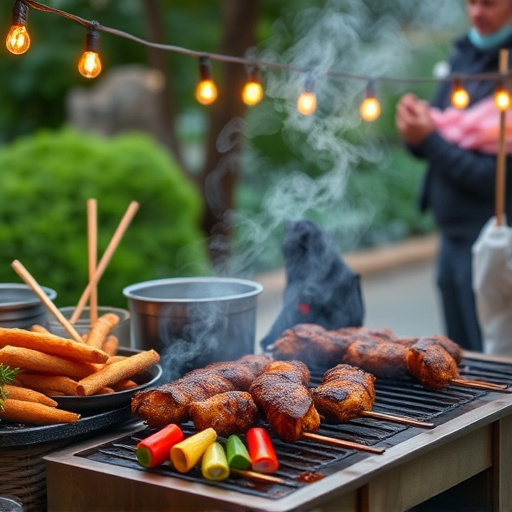
Ribs are a beloved treat in the BBQ world, offering a tender and flavorful experience that’s hard to beat. When it comes to choosing between grilling and oven methods for cooking ribs, understanding your cut is key. The most common types for BBQ pork rib recipes include baby back, spare rib, and St. Louis-style ribs, each with distinct bone structures and meat arrangements.
Preparation varies slightly depending on the type, but all ribs benefit from a dry rub or marinade to infuse flavor. Before cooking, remove any membrane on the bone side of the ribs for optimal tenderness. This simple step makes a significant difference in the final product. For grilling, prepare your BBQ with indirect heat, creating a warm zone for slow-roasting the ribs. Oven methods typically involve high heat at the beginning followed by reduced heat for slow cooking, ensuring those mouthwatering, fall-off-the-bone results.
The Science Behind Cooking Ribs: Why Temperature Matters
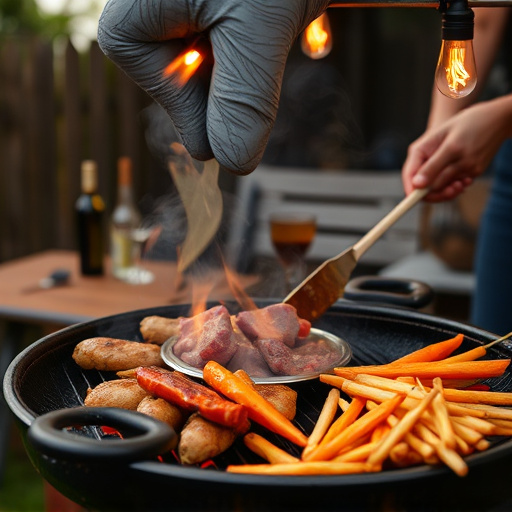
Cooking ribs is a science, and understanding the role of temperature is key to achieving the perfect BBQ pork rib recipe. The collagen in pork ribs slowly breaks down as it cooks, transforming into gelatin, which helps the meat become tender. This process occurs best within a specific temperature range—typically between 200°F (93°C) and 250°F (121°C). Lower temperatures can result in slow collagen breakdown, leading to tough ribs, while higher temps can cause the meat to dry out and become stringy.
The two-step cooking method—a combination of grilling and oven baking—is ideal for reaching that sweet spot. Initial high-heat grilling seals in juices, caramelizes sugars, and forms a delicious crust on the rib’s surface. Then, lower temperatures in the oven allow slow, even cooking, ensuring the interior reaches tenderness while maintaining moisture. This scientific approach ensures ribs become melt-in-your-mouth delicious, satisfying any BBQ pork rib recipe enthusiast.
Grill Method: Achieving That Charred, Smoky Flavor
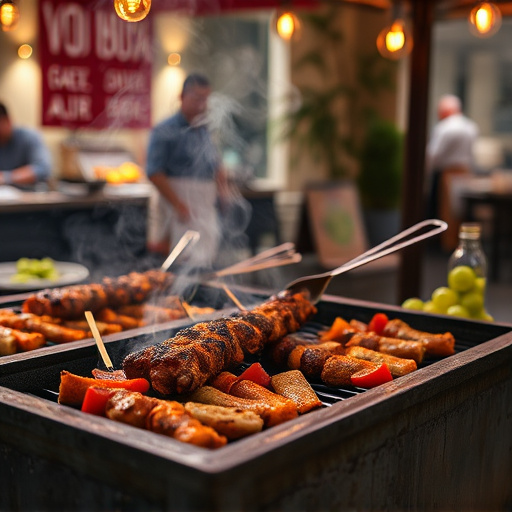
The grill method for preparing BBQ pork ribs is a favorite among many culinary enthusiasts, as it imparts a unique charred and smoky flavor that’s hard to replicate in an oven. To achieve this mouthwatering taste, the key lies in high heat and indirect cooking. Start by preheating your grill to a temperature between 400-450°F (200-230°C). This intense heat sears the surface of the ribs, locking in juices and creating a delicious crust.
While maintaining this high heat, place the ribs on the grill with the bone side up. Allow them to cook undisturbed for about 2-3 minutes until char marks start to appear. Then, using long-handled tongs, flip the ribs over to sear the other side. This technique ensures even cooking and helps develop that coveted smoky flavor. Continue grilling until your desired level of doneness is reached—whether it’s tender and slightly charred or deeply smoked.
Oven Method: A Slow and Steady Approach for Tender Ribs
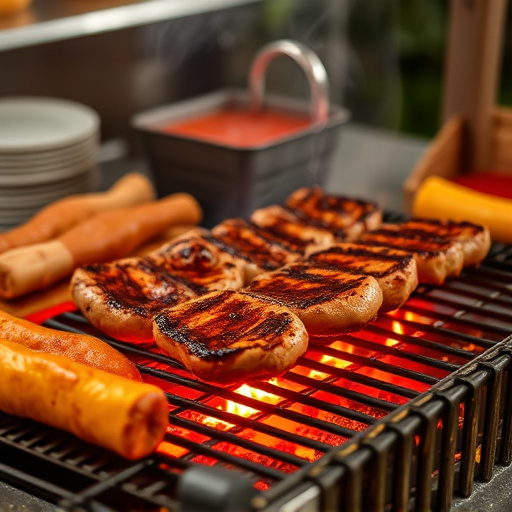
The oven method is a slow and steady approach for achieving tender, mouthwatering BBQ pork ribs. Unlike the grill, which can char and burn the meat quickly, the oven allows for even heat distribution, ensuring the ribs cook uniformly. This gentle cooking process breaks down connective tissues naturally, resulting in ribs that slip off the bone with just the right amount of caramelized glaze.
For this method, you’ll need to prepare your ribs by applying a dry rub or marinading them ahead of time. Then, place them in a baking dish and cover them tightly with foil. The initial low-temperature bake softens the ribs, making them more susceptible to further cooking. After several hours, remove the foil to allow the ribs’ surface to caramelize, enhancing their flavor and texture. This two-step process is ideal for those who prefer a hands-off approach or lack access to a grill, ensuring you still end up with an exceptional BBQ pork rib recipe.
Marinades and Rubs: Enhancing the Flavor Profile

Marinades and rubs are essential components in crafting a mouthwatering BBQ pork rib recipe. These flavor enhancers take your ribs from good to extraordinary. Marinades, with their ability to tenderize meat and infuse flavors, offer a moist and delicate end product. Typically made with a combination of acids (like vinegar or citrus juices), oils, spices, and herbs, marinades can transform the taste and texture of pork ribs, making them irresistibly succulent.
Rubs, on the other hand, provide a dry rub of spices that creates a robust and savory crust. The direct application of these seasoned blends allows for a deep, complex flavor profile to develop as the ribs cook. Whether you choose a classic BBQ rub blend or create your own unique mix, using a generous amount while grilling or baking ensures that each rib is coated evenly, resulting in a tender, flavorful, and satisfying BBQ pork rib recipe.
Choosing the Right BBQ Sauces for Your Ribs
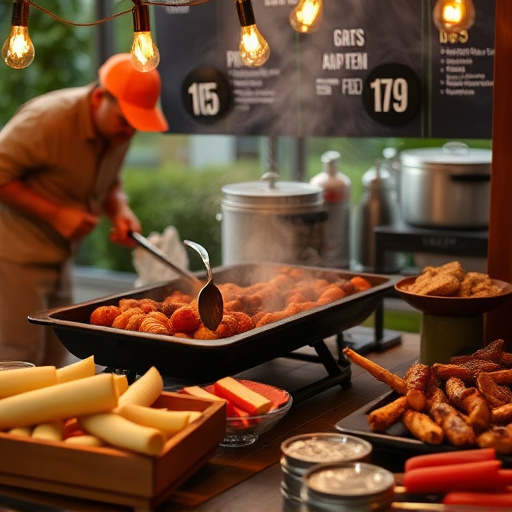
When it comes to a BBQ pork rib recipe, the right sauce can elevate your dish from good to great. The key is balancing sweetness, tanginess, and smokiness—a combination that caters to various palates. For a classic approach, opt for a Kansas City-style sauce with its signature tomato base, vinegar kick, and hint of brown sugar. This blend complements the rich, tender ribs beautifully. Alternatively, if you prefer a more diverse flavor profile, try a dry rub first, letting it caramelize on the ribs in the oven or grill, then applying a different sauce—like a spicy apple cider vinegar glaze—for a two-step flavor experience.
Consider your cooking method when choosing sauces. For grill lovers, a thick, sticky barbecue sauce is ideal, as it coats the ribs and adds a smoky flavor from the charring process. In contrast, oven-cooked ribs often pair best with lighter, more tangy sauces that cut through the meat’s richness. Whether you’re a traditionalist or an adventurous cook, taking the time to select the perfect BBQ sauce will undoubtedly enhance your rib recipe.
Tips for Serving and Pairing Your Perfect Ribs
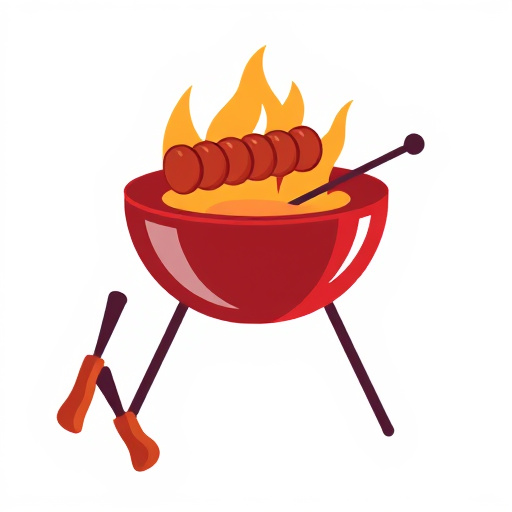
When serving your mouthwatering BBQ pork ribs, consider a few simple tips for an exceptional dining experience. Pair them with classic side dishes like coleslaw or baked beans to balance the flavors. Grilled or oven-roasted ribs are incredibly versatile; offer a variety of dipping sauces such as barbecue, tomato-based, or a tangy vinegar option to cater to different preferences.
For a complete BBQ Pork Rib Recipe feast, consider serving them with crusty bread for sopping up the rich sauce. Don’t be afraid to experiment with seasonings and sauces to create your signature blend, ensuring every bite is an explosion of flavor.
